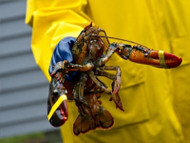How to Tell a Male Lobster from a Female Lobster
Oct 18th 2015
When people come to visit our outdoor tanks at Bayley’s Lobster Pound, one of the most requested lessons is how to tell a male lobster from a female lobster. Although I will describe it here, feel free to drop by and ask us for a demonstration.
When you flip a lobster over, you will notice that on the underside of the tail there are a lot of little, feathery appendages. These are called swimmerettes and the lobsters use them along with their legs to move forward in the water. When they want to swim quickly or flee a situation, they flap their tails and move backward. The first set of swimmerettes (closest to the body of the lobster) tells you the sex of the lobster. If that set of swimmerettes is hard and bony, you have a male lobster. If they are light and feathery, you have a female lobster. In the image that you see here, Jeff’s thumbs are touching the swimmerettes in question. The lobster on the right is a female and the one on the left is the male.
It is often possible to identify males and females by looking at the lobsters from above because the females often have tails that flay out more in order to allow them to hold eggs. Just because a female lobster has a wider tail, it does not necessarily mean that you will get more meat, you may just get more roe!
When choosing lobsters for your dinner, the major difference between males and females is that you will sometimes find lobster eggs (known as roe or coral) inside the tail. During soft-shell season, this is very unlikely. I often get asked which taste better, male or female lobsters. I can honestly tell you that even after thirty years of being with lobsters every day that I would not be able to tell the meat of a male from a female. Despite what television chefs may tell you, there simply is no discernible taste difference.



